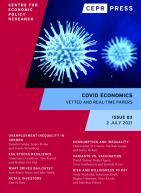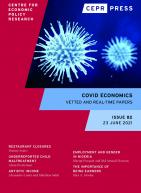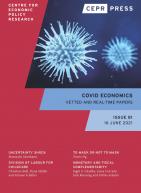
This note lays out the basic Susceptible-Infected-Recovered (SIR) epidemiological model of contagion, with a target audience of economists who want a framework for understanding the effects of social distancing and containment policies on the evolution of contagion and interactions with the economy. A key parameter, the asymptomatic rate (the fraction of the infected that are not tested under current guidelines), is not well estimated in the literature because tests for the coronavirus have been targeted at the sick and vulnerable, however it could be estimated by random sampling of the population. In this simple model, different policies that yield the same transmission rate ? have the same health outcomes but can have very different economic costs. Thus, one way to frame the economics of shutdown policy is as finding the most efficient policies to achieve a given ?, then determining the path of ? that trades off the economic cost against the cost of excess lives lost by overwhelming the health care system.
Citation
Stock, J (2020), ‘Data Gaps and the Policy Response to the Novel Coronavirus‘, COVID Economics 3, CEPR Press, Paris & London. https://cepr.org/publications/covid-economics-issue-3#392514_392879_390373
New York City is the hot spot of the Covid-19 pandemic in the United States. This paper merges information on the number of tests and the number of infections at the New York City zip code level with demographic and socioeconomic information from the decennial census and the American Community Surveys. People residing in poor or immigrant neighbourhoods were less likely to be tested; but the likelihood that a test was positive was larger in those neighbourhoods, as well as in neighbourhoods with larger households or predominantly black populations. The rate of infection in the population depends on both the frequency of tests and on the fraction of positive tests among those tested. The non-randomness in testing across New York City neighbourhoods indicates that the observed correlation between the rate of infection and the socioeconomic characteristics of a community tells an incomplete story of how the pandemic evolved in a congested urban setting.
Citation
Borjas, G (2020), ‘Demographic Determinants of Testing Incidence and COVID-19 Infections in New York City Neighborhoods‘, COVID Economics 3, CEPR Press, Paris & London. https://cepr.org/publications/covid-economics-issue-3#392514_392879_390374
In this paper, we conduct a comprehensive review of different economic policy measures adopted by 166 countries as a response to the COVID-19 pandemic and create a large database including fiscal, monetary, and exchange rate measures. Furthermore, using principle component analysis (PCA), we construct a COVID-19 Economic Stimulus Index (CESI) that combines all adopted policy measures. This index standardises economic responses taken by governments and allows us to study cross-country differences in policies. Finally, using simple cross-country OLS regressions we report that the median age of the population, the number of hospital beds per-capita, GDP per-capita, and the number of total cases are all significantly associated with the extent of countries’ economic policy responses.
Citation
Elgin, C, A Yalaman and G Basbug (2020), ‘Economic Policy Responses to a Pandemic: Developing the COVID-19 Economic Stimulus Index‘, COVID Economics 3, CEPR Press, Paris & London. https://cepr.org/publications/covid-economics-issue-3#392514_392879_390375
What is the impact of anxiety on vote choice? Building on a well-documented phenomenon in finance, we posit that voters will exhibit a “flight to safety†by turning toward establishment candidates. We test this theory in the context of the Democratic primary election of 2020 by examining changes in the vote shares of Bernie Sanders, a candidate promising disruptive change. We use the outbreak of the novel coronavirus across both space and time to identify a causal effect of the outbreak on voting. By comparing counties with and without reported cases in their local media market, before and after the outbreak of the virus, we show that COVID-19 resulted in diminished support for Sanders as compared to his support in the 2016 election, and interpret this to be the result of COVID-induced anxiety altering vote choice. We test alternative mechanisms, such as differential changes in turnout by age groups more and less supportive of Sanders, selection effects in which areas less supportive of Sanders were more exposed, and the coincident timing of the outbreak with the Democratic party rallying around Biden. We find little support for these alternative pathways, bolstering our claim that the results are consistent with a political flight to safety. Our findings suggest an as-yet underappreciated preference for “safe†candidates in times of social anxiety.
Citation
Honig, D and J Bisbee (2020), ‘Flight to Safety: 2020 Democratic Primary Election Results and COVID-19‘, COVID Economics 3, CEPR Press, Paris & London. https://cepr.org/publications/covid-economics-issue-3#392514_392879_390376
The health crisis caused by the outbreak of the Covid-19 virus has led many countries to implement drastic measures of social distancing. By reducing the quantity of labour, social distancing in turn leads to a drop in output which is difficult to quantify without taking into account relationships between sectors. Starting from a standard model of production networks, we analyse the sectoral effects of the shock in the case of France. We estimate that six weeks of social distancing brings GDP down by 5.6%. Apart from sectors directly impacted by social distancing measures, those whose value-added decreases the most are upstream sectors, i.e. sectors most distant from final demand. The same exercise is carried out for other European countries, taking into account national differences in sectoral composition and propensity to telework. Finally, we analyse the economic impact of phasing out social distancing by sector, region or age group.
Citation
Grassi, B, J Sauvagnat and J Barrot (2020), ‘Sectoral effects of social distancing‘, COVID Economics 3, CEPR Press, Paris & London. https://cepr.org/publications/covid-economics-issue-3#392514_392879_390377
We measure the economic risk of Covid-19 at a geo-spatially detailed resolution. In addition to data about the current prevalence of confirmed cases, we use data from 2014-2018 to compute measures for exposure, vulnerability, and resilience of the local economy to the shock of the epidemic. Using a battery of proxies for these four concepts, we calculate the hazard and the principal components of exposure and vulnerability to it, and of the economy’s resilience (i.e., its ability to recover rapidly from the shock). We find that the economic risk of this pandemic is particularly high in most of Africa, the Indian subcontinent, the Persian Gulf, and Southeast Asia. These results are consistent when comparing an ad hoc equal weighting algorithm for the four components of the index, an algorithm that assumes equal hazard for all countries, and one based on an estimated weights using previous aggregated disability-adjusted life years losses associated with communicable diseases.
Citation
Park, D, B Ferrarini, I Noy and N Doan (2020), ‘Measuring the Economic Risk of COVID-19‘, COVID Economics 3, CEPR Press, Paris & London. https://cepr.org/publications/covid-economics-issue-3#392514_392879_390378


Covid Economics - Issue 82
- Restaurant Closures during the Pandemic: A Descriptive Analysis
- Underreporting Child Maltreatment during the Pandemic: Evidence from Colorado
- Covid-19 impact on Artistic Income
- COVID-19, Employment, and Gender: Evidence from Nigeria
- The Importance of Being Earners: Modelling the Implications of Changes to Welfare Contributions on Macroeconomic Recovery
